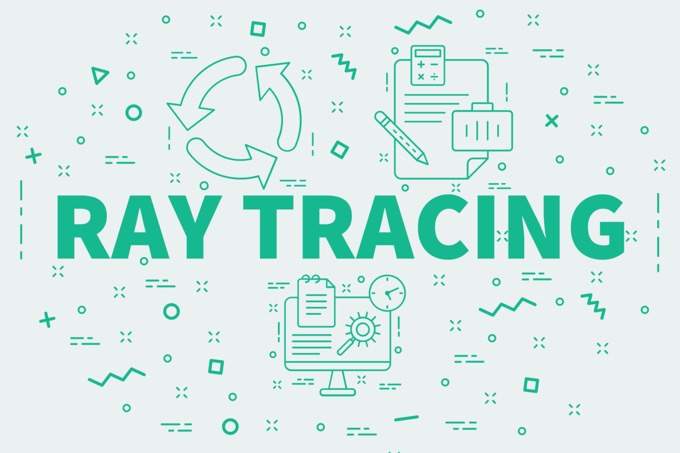Ray tracing is an advanced form of computer graphics that simulates the way light works in real life. It can create computer graphics that look truly photorealistic.
In the past, ray tracing was limited to massive computer graphics projects, such as Hollywood CG films. Now it’s found in PC gaming and soon, next generation gaming consoles.
To understand why this has so many people excited, we need to compare ray-traced graphics to the mainstream graphics rendering method that’s been used until now: rasterization.

Rasterization vs Ray Tracing
Modern real-time computer graphics look amazing! It’s hard to imagine that it has anything to do with the basic 3D graphics from twenty or thirty years ago. The truth is that a console like the Playstation 1 and the current Playstation 4 use the same basic method of rendering 3D graphics and then putting it on your 2D screen.
This is known as rasterization. A “raster” is an image shown as a grid of pixels, which is exactly what your screen displays. Rasterization is the process of converting a 3D scene into a 2D image on a screen.
This needs to be done, because the 3D scene is, well, 3D. It has depth, so the virtual objects can move past each other and be looked at from any point of view. In the process of rasterization, the computer has to figure out what that scene would look like if your screen was basically a window into that 3D world.

In real life, a scene has texture and lighting, as well as shape, depth and size. Since simulating light has traditionally taken more computer power than any home computer is capable of, programmers have created tricks and shortcuts to create something that looks close to real light, color and texture using this process of rasterization.
Ray tracing is, in one way, much simpler. Instead of trying to use a long list of tricks to create the illusion of real ight, it simulates real light instead. Now when the computer has to figure out what the scene would look like seen through the “window” of your screen, it just runs the ray tracing simulation and it all works out.
In the real world, the rays of light entering your eye have bounced off everything else you are looking at before reaching your retinas. Ray tracing achieves the same result in a more efficient way. It does this by shooting simulated “rays” of light from the “camera” and letting it bounce around the virtual scene, picking up color and brightness information on the way. Your screen represents the virtual eye, so you see a truly realistic virtual world.

By using ray tracing, a single technique creates objects, reflections, shadows and other elements of a scene that look real. That realism happens naturally as a result of the simulation, no tricks or shortcuts needed!
Where To Experience Ray Tracing
If you want to see ray tracing in action, all you have to do is watch any modern movie that uses computer-generated graphics. If you watch a CG film such as Toy Story 4, everything you’re seeing is a product of ray tracing.
If you want to explore an interactive ray-traced world, there’s currently only one game in town. The RTX series of Nvidia GPUs, along with video games and apps that support this technology. You can run some ray-tracing applications with non-RTX hardware, but you won’t get good performance. Be sure to check out our article on the best games that show off RTX hardware.

The problem is that RTX hardware is still quite expensive. However, the upcoming generation of video game consoles have a form of ray-tracing support. Which means that the mainstream gaming world may help turn ray-tracing into the next major gaming technology. Still, if ray-tracing is so difficult to do in real time, how do these new GPUs manage it?
How Is Real Time Ray Tracing Achieved?
Any computer can render a 3D scene using ray tracing. People who work with 3D rendering packages have been doing it for years. Any modern CPU can perform the actual calculations needed to trace the path of light around the scene.
However, modern CPUs and GPUs can’t crunch those numbers quickly enough to generate an image in real time. For example, the massive computer farms used to make films such as Monsters Inc or Toy Story take hours to render a single frame of the final product.
Modern video games, by contrast, need to generate at least thirty frames of images every second to be considered playable, with the gold standard currently set around the 60 frames per second mark.

So how can GPUs such as the Nvidia RTX series manage to use the ray-tracing method at playable frame rates? The answer is that they don’t use ray tracing for everything. At least not in modern titles.
The trick is to combine traditional graphics with selective ray-tracing. The RTX cards have dedicated ray-tracing hardware that sits along a more traditional GPU. In this way, ray-tracing can be used to compensate for some of the shortcomings of traditional graphics hardware.
There are video games you can play with an RTX card that are fully ray-traced. The best example is Quake II RTX. This is a decades-old video game that is simple enough that full real-time ray-tracing is possible. When it comes to applying pure ray-tracing to current video games however, it will still be years before such hardware becomes mainstream.
Is Ray Tracing the Future?
The short answer is yes, ray tracing is the future. The longer answer is that as hardware that makes real-time ray tracing possible becomes cheaper, we’ll probably see it replace traditional rendering bit by bit. If ray-traced graphics become a normal part of the new console generation, there will be no going back.
Developers can safely include ray-tracing features in their titles, because all popular platforms will support it. Since ray-traced graphics are superior, the stars really are aligning for the arrival of ray-tracing on affordable hardware. Which means that true photorealism may finally be here.

The other major sign that ray-tracing will become a mainstream rendering method is how it’s now being included in the common tools that developers use to make video games and other 3D applications. In other words, it’s no longer necessary for developers to invent their own ray-tracing solutions.
Popular graphics engines such as Unreal Engine 4 or Frostbite now include support for RTX hardware-accelerated ray-tracing. Making it much more likely that developers will include it as an option for their titles.
Should You Buy Into Ray Tracing Now?
At the time of writing, we are still at the first-generation of ray-tracing hardware. While prices have come down, performance is still pretty mediocre. If you’re a hardcore, early adopter then there’s plenty to like about ray-tracing on PC.
If you aren’t willing to spend hundreds or thousands of dollars as an early adopter, it’s better to invest in the next generation of mainstream consoles which promise to feature the technology, or wait for the successor to the RTX 20-series cards.